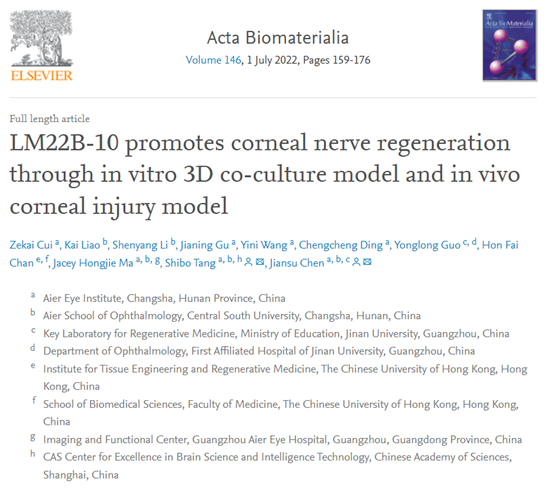
The research results of Prof. Jiansu Chen, Prof. Shibo Tang and associate researcher Zekai Cui from AIER Eye Institute were published in Acta Biomaterialia (recent impact factor: 10.633), an international journal in the field of biomedicine
With the advent of the era of the “Digital Screen”, a growing number of high-tech products, make more people focus their eyes and attention on screens for long periods, resulting in excessive eye fatigue,dry sensation, foreign body sensation, burning sensation, red eye itching, blurred vision, pain, photophobia tears, and serious corneal damage with even visual impairment. Corneal nerve damage is one of the factors causing these symptoms. Neurotrophic keratitis and diabetes can also cause corneal nerve damage, resulting corneal discomfort. However, the specific molecular mechanism of corneal nerve injury repair is not fully understood.
Based on their earlier stage achievements, Prof. Jiansu Chen, Prof. Shibo Tang and associate researcher Zekai Cui from AIER Eye Institute found that the human corneal stromal cells (referred to as hCSCs) cut from the SMILE surgery can be reused, turning waste into treasure (the results were published in <Journal of Cellular and Molecular Medicine>, and an in vitro corneal stromal and nerve co-culture 3D model was designed and constructed this time, the results were recently published in the journal Acta Biomaterialia.
It is understood that Acta Biomaterialia is the Top journal of the First District of the Chinese Academy of Sciences, with the latest impact factor of 10.633. It is an international journal in the biomedical field. The content of Acta Biomaterialia papers is also regarded as a certain industry indicator, which is highly recognized by the industry.
In this model, the team found that hCSCs and nerves interact. The nerve prevents hCSCs from apoptosis in the serum withdrawal medium, leading to the growth of nerve bundles. The small molecule LM22B-10 was also screened out by protein microarray and transcriptomic deep detection, which has the mechanism of promoting nerve regeneration and is stable and not easy to degrade. The construction of the dorsal root ganglion-corneal stromal cell co-culture 3D model has created a good platform and tool to explore the mechanism of corneal nerve regeneration and verification of drug effects.
The cornea has a high nerve density and is one of the most sensitive tissues In the human body. Studies have shown that the density of pain receptors in the cornea is 300 to 600 times that of the skin, 20 to 40 times that of the dental pulp, and any damage to the structure of the cornea can cause extreme pain to the patient. We know a healthy cornea has no blood vessels. oxygen and nutrients are provided to the corneal cells through tears and aqueous humour, and the corneal nerves also provide some nutrients, which play a crucial role in maintaining corneal homeostasis.
Based on this, after administering LM22B-10 eye drops to regular and diabetic mice with corneal wounding, the team found that LM22B-10 significantly improves the healing speed of the corneal epithelium, corneal sensitivity, and corneal nerve density. After passing preclinical trials and clinical trials, it can relieve and treat neurotrophic keratitis, diabetic keratitis and other corneal nerve injury-related diseases or symptoms. In general, compared with traditional nerve growth factors, LM22B-10 has the characteristics and advantages of high efficiency, easy degradation, low pain and low cost. It has great potential in nerve repair and corneal injury healing and is expected to become a new clinical treatment drug for corneal diseases.
“LM22B-10 has shown promising results in the treatment of corneal epithelial and corneal nerve injuries. Compared with other neurotrophins, LM22B-10 does not trigger the activation of pain receptors. Moreover, the small molecules are not as easily degraded as peptides, so the cost would be much lower. In the future, it is expected to become one of the specific drugs for ocular surface injury and nerve injury after preclinical trials and clinical trials.” On behalf of the team, Prof. Jiansu Chen said, “AIER Eye Hospital Group (referred to as “AIER”) is China's leading ophthalmology hospital group that covers Asia, Europe, and North America with a total number of more than 700 specialized eye hospitals and centres around the world, which has significant advantages for conducting multi-centre and large-sample studies.
We look forward to our colleagues making more contributions to the cause of human eye health by utilizing advanced stem cell, tissue engineering and eye regenerative medicine technologies in this international fertile ground.”
